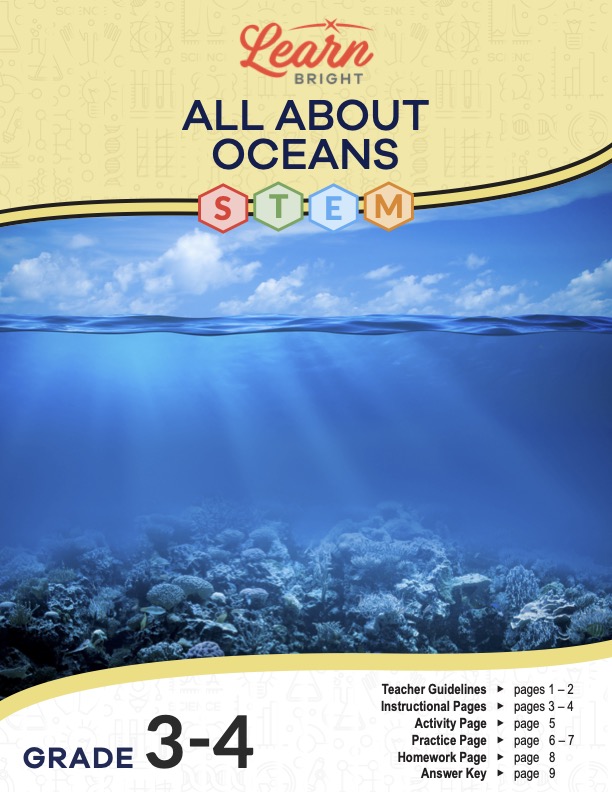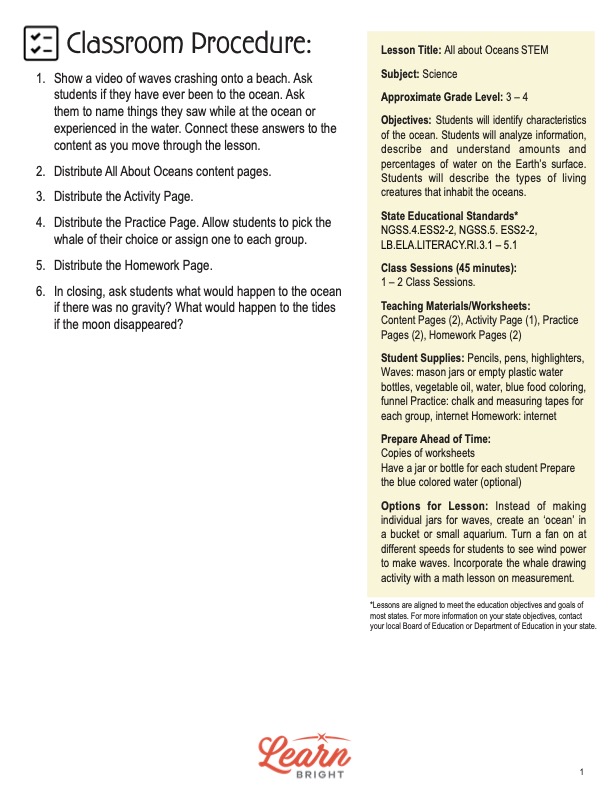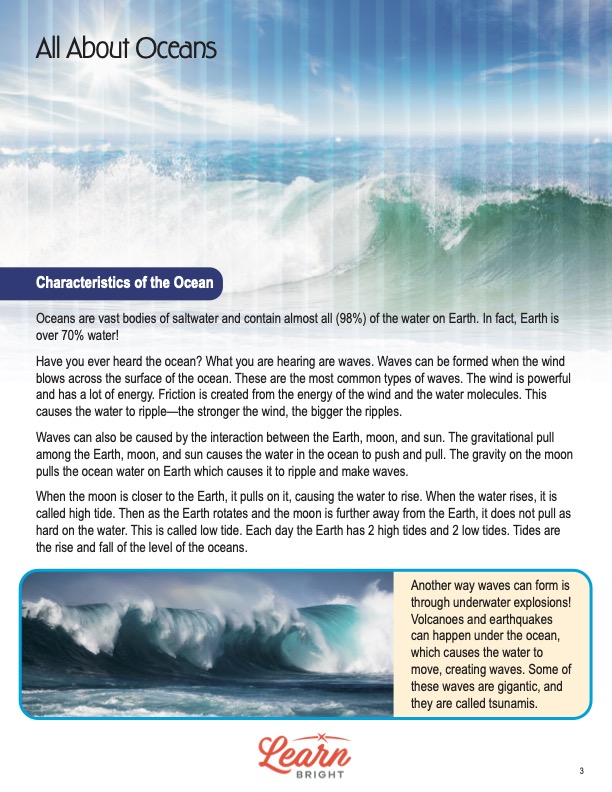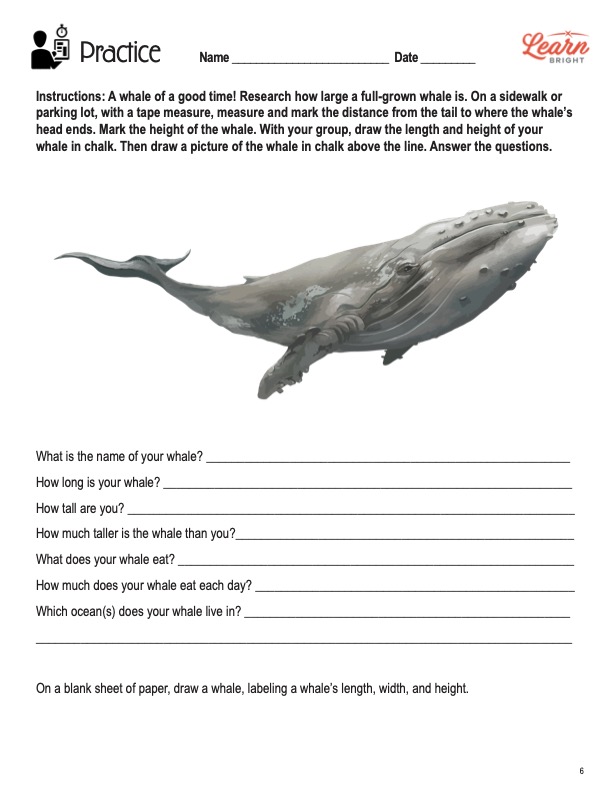Description
What our All about Oceans STEM lesson plan includes
Lesson Objectives and Overview: All about Oceans STEM explores the traits and properties of oceans. Students will learn to identify ocean traits and analyze information. They will also discover various types of living creatures that inhabit the planet’s oceans. This lesson is for students in 3rd grade and 4th grade.
Classroom Procedure
Every lesson plan provides you with a classroom procedure page that outlines a step-by-step guide to follow. You do not have to follow the guide exactly. The guide helps you organize the lesson and details when to hand out worksheets. It also lists information in the yellow box that you might find useful. You will find the lesson objectives, state standards, and number of class sessions the lesson should take to complete in this area. In addition, it describes the supplies you will need as well as what and how you need to prepare beforehand.
Options for Lesson
There are a couple of suggestions in the “Options for Lesson” section of the classroom procedure page that you might want to take advantage of. One idea is to create an “ocean” in a bucket or small aquarium rather than having students make individual wave jars. Another idea is to turn on a fan at different speeds so students can see how wind power creates waves. One more suggestion is to incorporate the whale drawing activity with a math lesson that involves measurement.
Teacher Notes
The teacher notes page provides an extra paragraph of information to help guide the lesson and remind you what to focus on. The blank lines on this page are available for you to write out thoughts and ideas you have as you prepare the lesson.
ALL ABOUT OCEANS STEM LESSON PLAN CONTENT PAGES
How Waves Form
The All about Oceans STEM lesson plan contains two content pages. Students will first learn that water covers 70% of the planet. Oceans are bodies of saltwater and contain almost all of the water on Earth, about 98%!
The sound we hear when listening to the ocean is a result of crashing waves. Waves form most often when wind blows across the surface of the water. The wind is powerful and contains a lot of energy. That wind energy, along with energy from water molecules, creates friction. This is how water starts to ripple. The stronger the wind, the bigger the ripples.
The interaction between the Earth, the moon, and the sun can also cause waves to occur. The gravitational pull among these three celestial bodies causes water in the ocean to push and pull. Gravity on the moon pulls ocean water on Earth, causing it to ripple and make waves. When the moon is closer to Earth, water levels rise, which is what we call high tide. As the Earth rotates, the moon is further away and cannot pull the water as hard. This is low tide. Every day, Earth has two high tides and two low tides.
One more way waves form involves explosions under water. Volcanoes and earthquakes can occur under the ocean. When they happen, the water starts to move, creating waves. Some of these waves are gigantic. We call these tsunamis, which are a type of natural disaster.
Ocean Floor Levels
Students will then learn about the different levels of the ocean floor. The shallowest part of the ocean is the continental shelf, which rests right next to the continents. When we play at a beach and swim in the ocean, we are swimming on top of this continental shelf layer. It is usually covered in layers of thick mud, rocks, and sand. From there, the ocean floor slopes downward into basins. At the very bottom of the basins are vast, flat plains called abyssal plains.
The lesson provides a diagram to help students better understand how this concept works. It labels different parts such as coastline, continental shelf, deep sea fan, submarine volcano, and oceanic crust. It also provides more general areas to which these various ocean parts belong. For instance, the coast includes both land mass and coastline. The deep ocean basin includes both deep sea fan and abyssal plain.
We call the large cracks on land canyons. However, a canyon on the ocean floor is called a trench. The Grand Canyon is about 5,300 feet deep. The Marianas Trench, one of the most famous ocean trenches in the world, is 36,198 feet deep! On average, though, the ocean is about 2.3 miles deep. And just like there are mountains on land, underwater mountain ranges exist in oceans as well. These are called oceanic ridges, and they sometimes have active volcanoes!
ALL ABOUT OCEANS STEM LESSON PLAN WORKSHEETS
The All about Oceans STEM lesson plan includes three worksheets: an activity worksheet, a practice worksheet, and a homework assignment. These worksheets will help students demonstrate what they learned throughout the lesson and reinforce the lesson concepts. The guide on the classroom procedure page outlines when to hand out each worksheet to your students.
OCEAN WAVES ACTIVITY WORKSHEET
For the activity, students will try to create ocean waves. First, they will fill a container halfway with water and add drops of blue food coloring. They will then fill the rest of the container with vegetable oil. After putting the lid on tight, they will rock the container back and forth to make waves. Before following the steps, they will respond to the PREDICT prompt. It asks them to predict what will happen when they mix the ingredients together. After following the steps, they will respond to the OBSERVATION prompt. It asks them if their prediction matches what they observed. They will finally answer how the experiment explains the movements in oceans.
WHALE OF A GOOD TIME PRACTICE WORKSHEET
Students will work as a group to complete this assignment. First, they will research how large a full-grown whale is. On a sidewalk or parking lot, they will measure the distance of an adult whale from head to tail using a tape measure. They will mark both ends, marking the length and height of the whale, using chalk. They will then draw a picture of a whale above their chalk line. Finally, students will answer the questions individually on their worksheets.
ALL ABOUT OCEANS STEM HOMEWORK ASSIGNMENT
The homework assignment requires students to pick an ocean animal to research. They will write the name of the animal and draw a picture of it. Then they will answer a series of prompts that can inform others about their chosen animal. The data they provide will include things like what the animal eats, what it looks like, and a couple fun facts.
Worksheet Answer Keys
There are answer keys in the lesson plan document. However, given the nature of the assignments, there are no questions or prompts with a single right answer. Students’ answers will all vary. If you choose to administer the lesson pages to your students via PDF, you can save a new file that omits these unnecessary pages. You could create your own reference answer key with sample responses of your choosing.











